Quick Lists
The list types exposed in the 'quick' menus are driven by the type of members selected (dates, measures, normal hierarchy elements etc). All quick lists can be fully customized and edited using the Formulate tools - which allow the user to construct almost ANY type of logical list operation possible within the given data model and language (PQL for SQL data sources and MDX for others).
Note: All quick lists built directly in Discover are initially built as one-of, report specific items. However, they can be promoted a sharable item. See here for more.
Types of Quick Lists
The heuristic engine in Pyramid changes the types of quick lists available based on what is selected. The selections can be made from both the element trees or directly from visuals.
Standard Lists
These are simple lists created by simply enumerating the selected elements or measures. You can build a standard list from one or more items without limit. Standard lists can include functional selections made in the elements tree as well rather than hand-picked elements. This offers a much larger set of choices for building sophisticated, automated list logic even by just using the standard listing option. For example, a listing of the 3 main metrics used in most analyses.

The standard list above is built off the selected items in a grid visual while the measures list below is built off the items highlighted in the measures element tree.

Variable Lists
These specialized type of list that can be used in your report to change or swap out the list of elements used in the query using a simple switch mechanism. As such variable lists are built, in a single step, using standard list constructs together with one or more parameters. Further, variable lists can be built on other lists - effectively becoming a technique to swap out entire lists with alternative lists in a single button click. For example, you may have 2 lists of products and you want to switch between the 2 lists. You could create a variable list out of the 2 lists, so the user can easily swap them out with a simple button click.
Note: The option for variable lists will not appear in the context menu's unless 2 or more selections have been made.
- Click here for more details and examples on Quick Variable Lists.
- Click here for more on variable lists in general and how to use the Variable list Wizard for more complex setups.
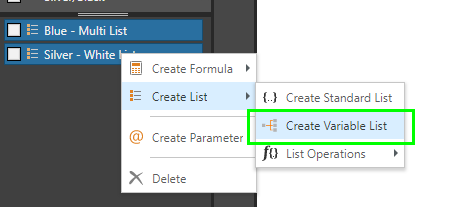
Date-Time Lists
These functional methods are designed to produce special lists using date-time logic based on the selected element, which itself must come from a date-time hierarchy. The functional choices will heuristically change based on the type of the source date time element (dates, months, weeks, quarters etc). The resulting list will generate a collection of date-time items that below to the range. For example a Year-to-date function on a month element will produce a listing of all months from the start of the year to the currently selected month item.
Note: The option for date-time functional lists will not appear in the context menu's if more than a single selection has been made.
Note: There are slightly different functions available for MDX data sources (like MS OLAP, Tabular and SAP BW) versus PQL data sources (SQL based). The image below shows the function listing for SQL based date-time items. The second image shows the listing for OLAP dates.

Hierarchical Lists
These functional methods are designed to produce special lists using hierarchical logic based on the selected element, which itself must come from a multilevel hierarchy. The resulting list will generate a collection of related items based on the source element. For example the children function will produce a listing of all child elements for the given parent item.
Note: The option for hierarchical functional lists will not appear in the context menu's if more than a single selection has been made. It will also not appear on non multilevel hierarchy structures.

Cross Lists
These functional methods are designed to produce special lists using inter-sectional or 'cross' functions applied across 2 or more other lists. The functions are designed to find element intersections between 2 lists; multiple list unions; or to remove one list of items from a second list. For example finding the intersection between 2 independent lists: the first containing all products that have sales over $50 and the second containing products that were sold in the USA.
Note: The option for cross functional lists will not appear in the context menu's unless 2 or more list selections have been made. It will not work on elements directly,

Building Quick Lists
To build quick lists start by making selections of the relevant elements in the element trees or visuals. Then right click, and choose the relevant list logic from the context menus. See examples and the below for more.
Managing Quick Lists
Lists created from the quick menus can be fully edited, deleted and shared like any other list item in the system. Click here to read more on how to manage quick lists.
Examples
The following examples demonstrate standard, hierarchical and date time lists. See Variable lists for other examples.
In this example, the user simply selects the first 3 product colors from the grid visual. Then right clicks and choose "Standard List" to auto create a listing from these elements.

Once created, the user can simply use the list (or "set") from the custom elements tree in the product color hierarchy to always view these 3 product colors.
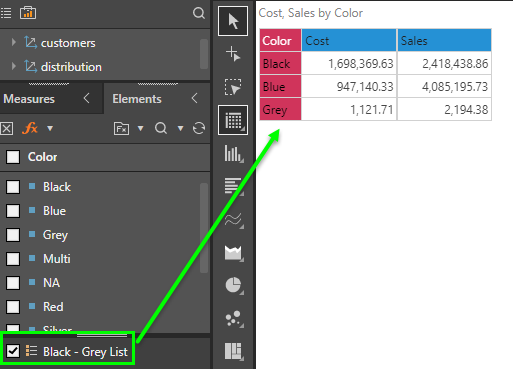
In this example, the user simply right clicks on Handlebars product sub-category. Then from the context menu choose Hierarchical Functions >Children to auto create a listing of child elements for Handlebars. Because this is functional selection, the list will dynamically change in the future if more products are added to this sub-category.
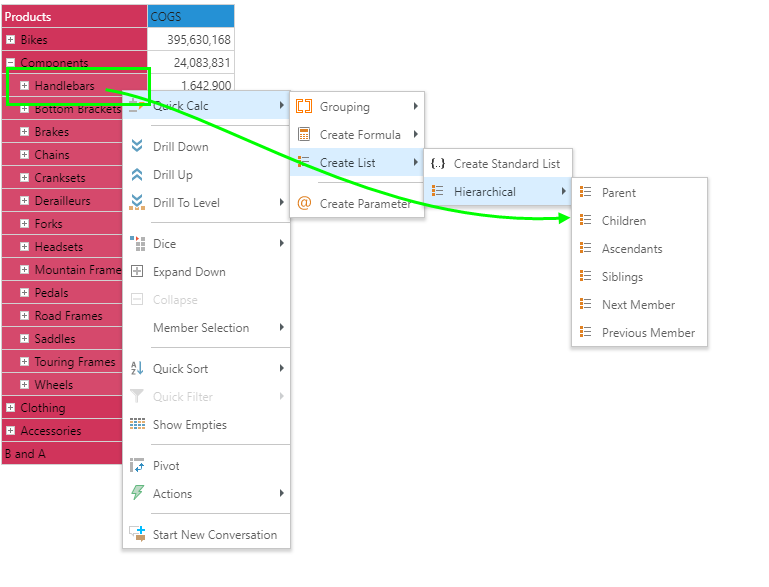
Once created, the user can simply use the list (or "set") from the custom elements tree in the product hierarchy to always view all the products in this sub-category.
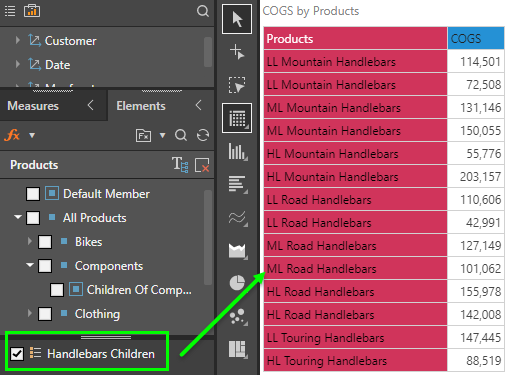
In this example, the user simply right clicks on a month in the date-month hierarchy elements tree. Then from the context menu choose Date Functions >Year to Date to auto create a listing of months from the start of the year up to the selected month: September 2018.

Once created, the user can simply use the list (or "set") from the custom elements tree in the date-time hierarchy to always view all the months in the range.
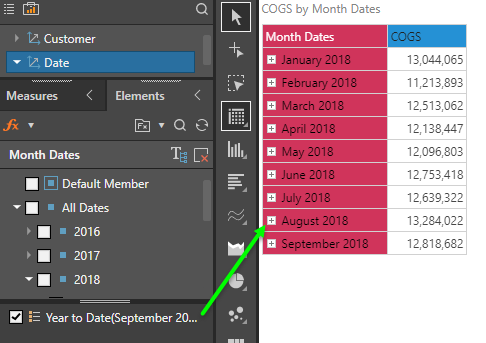
In this multi-step example, we'll first functionally build a list of all the child product elements of the 'mountain bikes' sub-category.

Next, we'll select all the products from the Product hierarchy using the right click selection context menu.
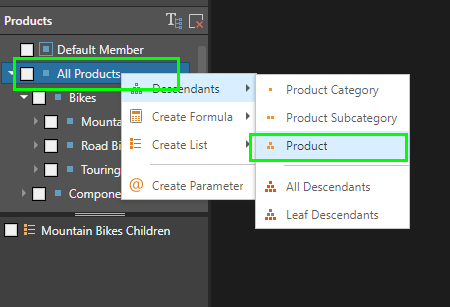
We'll next build a standard list using the level selection (shown below). Since the elements are functionally selected from the above step, the standard list will fully ENCAPSULATE this functional selection, allowing it to change automatically in the future if the underlying list of products changes.
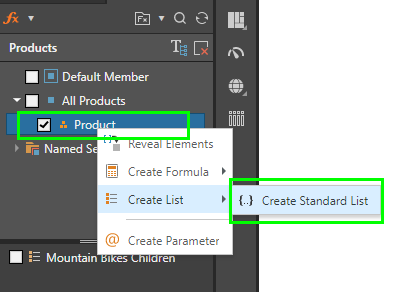
Next, clicking on our 2 separate lists made from the above steps, we are going to build a composite cross list that is all products EXCEPT for mountain bike products. Clicking on the full product list first, then the mountain bikes children list second, we right click and choose the Except functional list.

Last, using our new composite list, we can see a list of all the desired products, which importantly are dynamically built and can change if there are any updates to either listing in the future.
